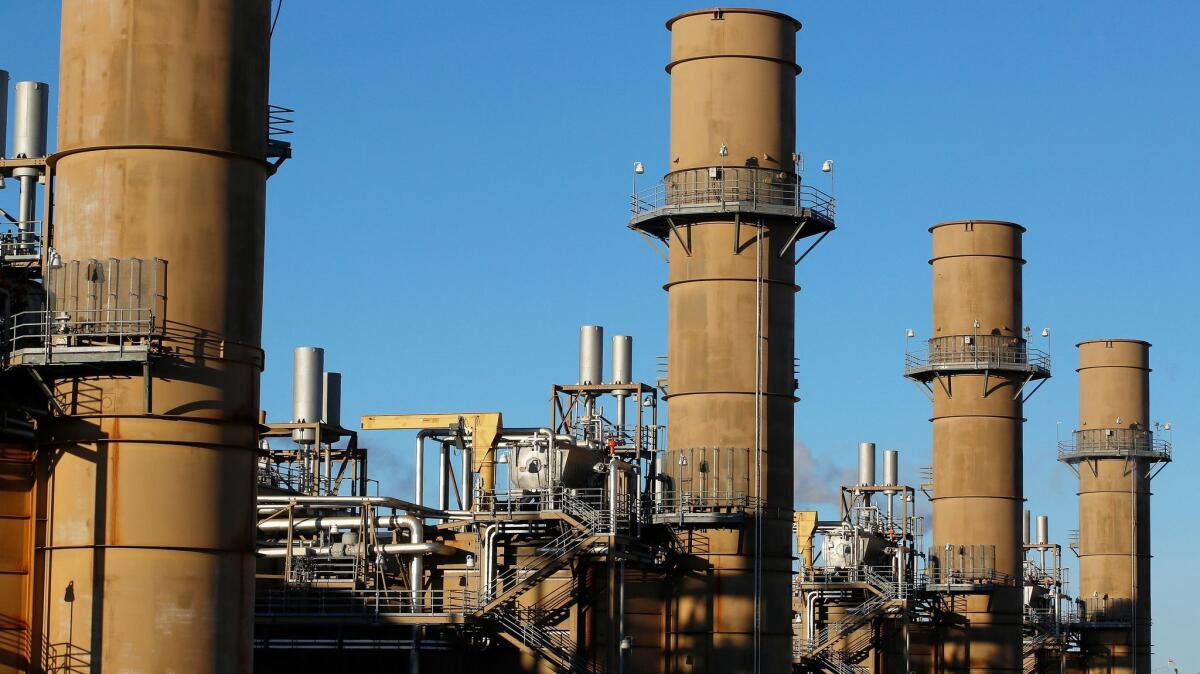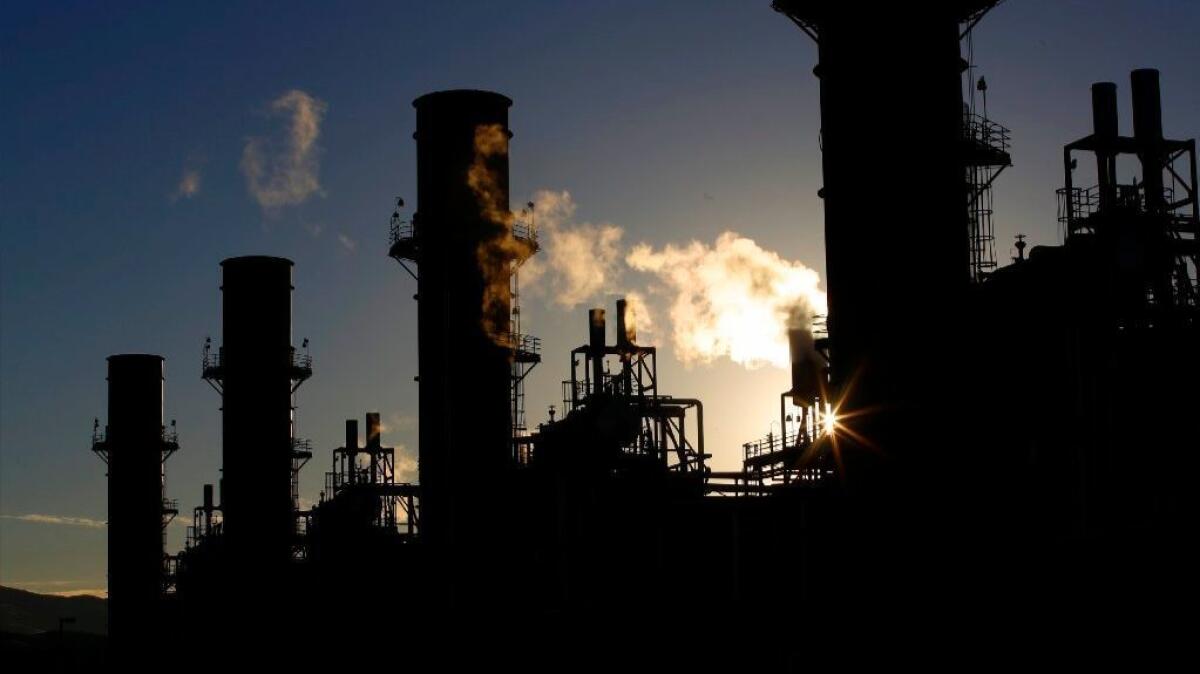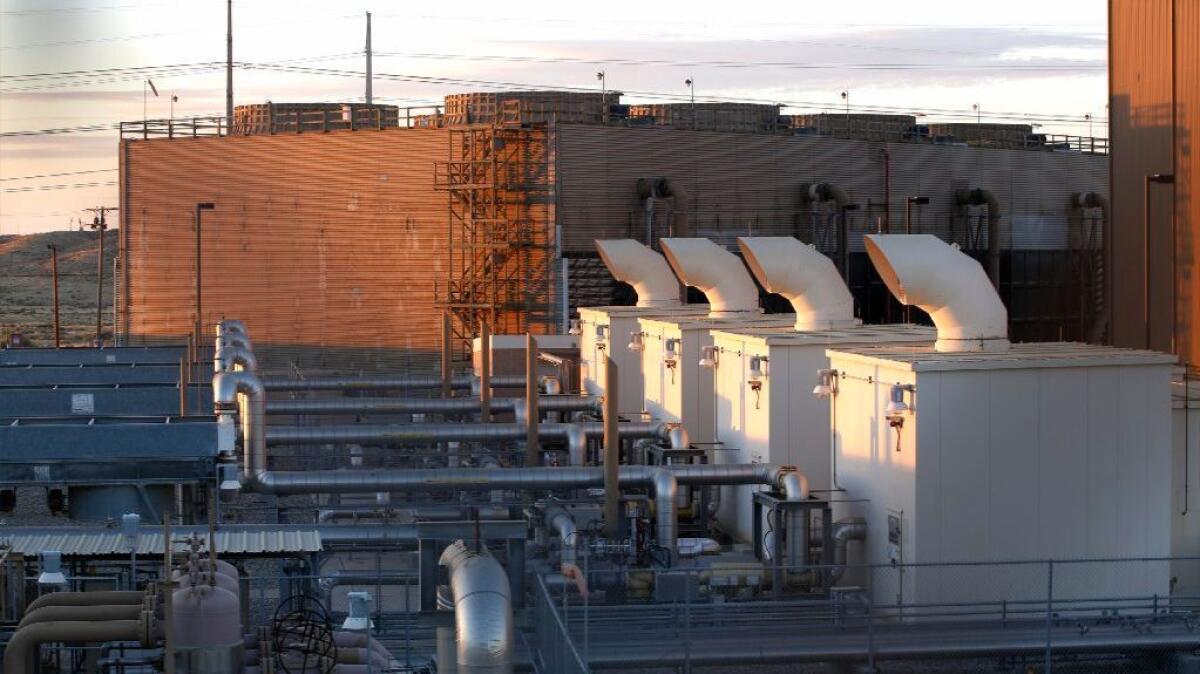A Central Valley power plant may close as the state pushes new building at customers’ expense

- Share via
The giant La Paloma power plant has run hard since it opened in 2003, with owners boasting that its home near Bakersfield is ideal for sending electricity up toward San Francisco or down to Los Angeles area homes and businesses.
The independent power plant sits close to a key transmission connection between areas served by Southern California Edison and Pacific Gas & Electric. That has allowed La Paloma’s electrons to zip easily north or south despite a sometimes jammed transmission link-up between the utilities’ historic territories.
This advantage has helped the natural-gas power generator become California’s most heavily used independent power plant in the past decade behind only PG&E’s Diablo Canyon nuclear plant.
But now La Paloma is in bankruptcy proceedings and may be shut down because the agency that operates the state’s power grid has decided that the facility’s Kern County location isn’t that great, after all. The power plant, about 110 miles northwest of Los Angeles, is too far to dependably provide electricity to the city and its environs, the agency has determined.
“We can’t rely on the La Paloma plant because it’s outside of the L.A. basin,” said Neil Millar, executive director of infrastructure development at the California Independent System Operator, which manages the long-distance transmission lines for most of the state. “It is here, all about location, I’m afraid.”
Instead, the agency has supported construction of the Puente power plant in Ventura County, which would cost about $250 million and would be paid for by electricity customers. La Paloma, just 14 years into a lifespan that could stretch 30 or 40 years, is all paid up, built by private developers at a cost of about $500 million.
We can’t rely on the La Paloma plant because it’s outside of the L.A. basin.
— Neil Millar, California Independent System Operator

Critics say that effectively replacing La Paloma with an expensive new plant is shortsighted and wasteful, and underscores the arbitrary decision-making that has led to Californians paying about 50% more for electricity than the national average.
Other large independent power plants in the state, including the Sutter Energy Center, have closed decades ahead of schedule, while regulators have approved construction of new natural gas plants with utility customers covering the new costs.
Although a plant closer to Los Angeles might be marginally more reliable, the difference in distance isn’t sufficient to justify sticking ratepayers with the costs of building a new power plant, especially given La Paloma’s long track record, critics contend.
La Paloma is a roughly 1,000-megawatt natural gas plant that can power more than 700,000 homes. It is near a natural gas pipeline, so isn’t required to tap the troubled Aliso Canyon natural gas storage facility, which has an uncertain future after a leak in October 2015 lasted four months and forced thousands from their homes in the nearby Porter Ranch community.
“La Paloma is important,” said Gary Ackerman, president of the Western Power Trading Forum, an association of independent power producers whose members include La Paloma’s owner.
“It’s capable of adjusting or accommodating a growing amount of renewable energy. It has flexibility. It has elements of reliability, and it doesn’t need Aliso Canyon,” he said.
La Paloma’s troubles came to a head last year with low market power prices, the lack of a guaranteed contract for its electricity and a new annual review by the grid operator of local electricity demand in the Los Angeles area and nine other state energy regions. That review didn’t show La Paloma meeting the power needs of the Los Angeles area “nor has any other study,” the system operator told federal regulators in a July 2016 federal filing.
The review was conducted with a new premise: Each region should be energy self-sufficient, the agency determined, supplied with electricity primarily from natural gas plants within the region to more reliably respond to sudden drops in electricity supply from solar, wind and other renewable sources.
La Paloma fell outside the boundaries of the Los Angeles region as well as the regions containing the state’s major cities to the north. The plant, whose name means “the dove” in Spanish, suddenly found it had little market demand for its power and no state “reliability must run” contract that pays certain well-located suppliers to stand ready to ramp up their facilities at a moment’s notice.
The regional boundaries have been used to justify construction of as many as seven new natural gas projects in Southern California, in addition to the Puente plant in Ventura County, even though solar and other renewable power generation are growing rapidly and the state already has a glut of power generating capacity.
California Independent System Operator officials say the rapid growth of renewable power is why the agency is pushing for natural gas facilities close to where consumers use the electricity. It’s important, they say, to ensure reliability for the times when the sun isn’t shining and the wind isn’t blowing.
The additional power plants, however, have created redundancies and excess power that is becoming expensive and ignores the changing dynamics of electricity production and storage.
A recent Los Angeles Times investigation found that power plants such as La Paloma are closing as a result of a glut of electricity capacity in the state. At the same time, regulators continue to approve more plants and increase electricity rates, even though California consumers are using less power.
The excess electricity and building of new power plants, transmission lines and related equipment means Californians are paying $40 billion a year for electricity, $6.8 billion more than nine years ago.
Some blame the high cost and the power glut on the state’s emphasis on clean energy such as solar and wind power projects, which don’t produce electricity 24 hours a day. Others point to utilities wanting to build plants, transmission lines and other equipment to make profit.
The most vocal critics of California’s electricity system argue that La Paloma’s travails — along with other plants that have closed or are facing shutdown — resulted from poorly designed energy policy.
In filing for bankruptcy, La Paloma blamed market factors such as low natural gas prices, California’s increasing use of renewable energy and slow growth in electricity demand, “exacerbated by an inhospitable regulatory environment.”
Ackerman also pointed to state legislators and energy regulators.
“You told them to build. You told the utilities to buy the energy,” Ackerman said. “That was the policy of the state and it overbuilt. It over-procured energy, and therein lies the problem.”
The excess capacity — designed to help avoid another disastrous period like the 2000-2001 energy crisis that left Californians in the dark with rolling blackouts — might worsen the problem it was meant to solve, Ackerman said.
“It’s a pretty difficult situation,” he said. “Eventually, it’s just going to come crashing down.”

La Paloma, the state’s 11th-largest power plant, has typically run far above the average natural gas plant, as much as roughly 78% of its potential to produce power. But it has experienced double-digit declines in usage over the last two years to a nearly all-time low of less than 50%.
“Absent some change in compensation, La Paloma has determined that continued economic operation of the La Paloma facility is not justified, at least in the short to medium term,” James Maiz, a partner in La Paloma majority owner Rockland Capital LLC, told the Federal Energy Regulatory Commission last June as part of a petition to save the plant.
Maiz added that the company projected an annual loss of $39 million without a reliability contract from the state or other support. Maiz did not return repeated phone calls seeking comment.
Unlike regulated, investor-owned utilities — Southern California Edison, Pacific Gas & Electric and San Diego Gas & Electric — La Paloma’s owner doesn’t have retail customers who pay for the plant. Older independent plants such as La Paloma lack the kind of contracts newer plants receive that allow for recovery of construction costs from the utilities’ customers.
For example, the Puente power project in Ventura County that state regulators favor over La Paloma is being developed by Edison and will be built and owned by NRG Energy Inc., based in Houston. Edison customers would foot the bill for the plant’s construction over some 20 years, regardless of how much the plant runs.
The contract for a new plant “is the ultimate security for the private company,” said Bill Powers, a San Diego engineer who testifies in state utility cases. “They get one of these contracts and they’re golden.”
Without such support, plants such as La Paloma have difficulty competing in the market, unless they can secure a contract for their power — something the power plant has been unable to do at a price that makes sense. And no one is offering La Paloma a contract.
“If La Paloma was not able to secure contracts it was because other facilities offered the utilities better value than La Paloma,” said Terrie Prosper, a spokeswoman for the California Public Utilities Commission.
“The ISO has a process where it can pay a power plant that provides critical capacity to keep operating even if the plant does not have a utility contract,” Prosper said. “In this situation, the ISO did not see a need to execute that process.”
In October, federal energy regulators denied La Paloma’s request for contract help, stating that La Paloma did not indicate that it had made attempts to avoid financial losses other than seeking to cut operations to save money.
In December, La Paloma Generating Station LLC filed for Chapter 11 bankruptcy protection, listing assets between $100 million to $500 million and liabilities of $500 million to $1 billion.
Times data editor Ben Welsh and staff writer Ryan Menezes contributed data analysis, which has been released as open-source software.
For more energy news, follow Ivan Penn on Twitter: @ivanlpenn
ALSO
State regulators want a study of clean alternatives to an Oxnard natural gas plant
California regulators weigh whether the state needs more power plants
Why are so many CEOs bashing Trump over the Paris accord? Money and public opinion
More to Read
Inside the business of entertainment
The Wide Shot brings you news, analysis and insights on everything from streaming wars to production — and what it all means for the future.
You may occasionally receive promotional content from the Los Angeles Times.











